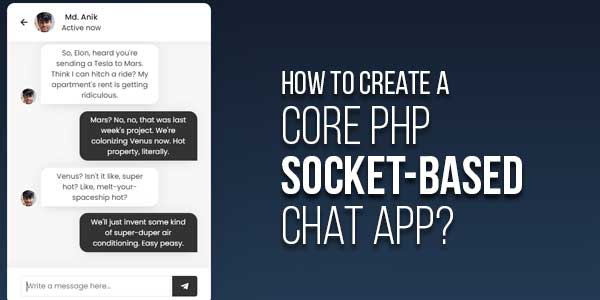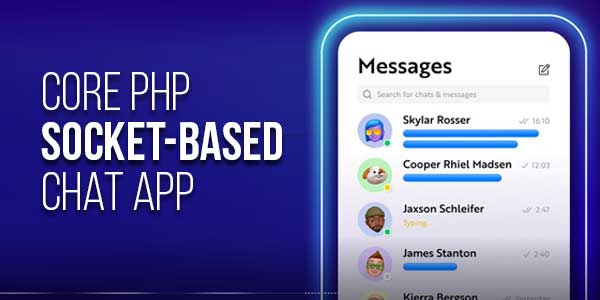
Remember the first time you used a real-time chat application? That magical feeling of seeing messages appear instantly, without refreshing the page? I sure do. It felt like actual wizardry back in the day.
Fast forward to today, and I’ve built more chat systems than I can count. But you know what’s funny? I still get that same thrill every time I create a new one using core PHP and sockets. There’s something incredibly satisfying about building real-time communication from the ground up.
Now, I know what you’re thinking: “Why bother with core PHP when there are so many frameworks and libraries out there?” Well, my friend, sometimes you need to understand the fundamentals before you can truly appreciate the abstractions. Plus, knowing how to build this with just PHP gives you a superpower that many developers don’t have.
Table of Contents
What Are Web Sockets and Why Should You Care?
Let’s start with the basics. Traditional web applications work on a request-response model. Your browser asks for something, the server responds, and that’s it. But for real-time applications like chat, this just doesn’t cut it. You’d need to constantly poll the server, asking “Any new messages? How about now? Now?”
That’s where web sockets come in. They create a persistent, two-way connection between the client and server. Once established, either side can send messages at any time. It’s like having a direct hotline instead of sending letters back and forth.
“Web sockets transform the stateless nature of HTTP into a persistent, real-time communication channel that completely changes what’s possible in web applications.”
Now, PHP isn’t traditionally known for its real-time capabilities. Most people think of PHP as that language that powers WordPress and handles form submissions. But with the power of sockets? Oh, it can do so much more.
Setting Up Your Development Environment
Before we dive into code, let’s make sure you have everything you need. I’ve seen too many developers get stuck because they skipped this crucial step.
What You’ll Need
- A local server environment (XAMPP, WAMP, or MAMP)
- PHP 7.4 or higher (we need those sweet, sweet socket functions)
- A text editor or IDE (I’m partial to VS Code, but use what you love)
- Basic knowledge of PHP, HTML, and JavaScript
- A terminal or command prompt you’re comfortable with
extension=sockets and remove the semicolon if it’s commented out.Checking Your PHP Socket Support
Let’s do a quick check to make sure your PHP installation has socket support. Create a file called phpinfo.php with this content:
<?php phpinfo(); ?>
Run it in your browser and search for “sockets”. If you see the sockets section, you’re golden! If not, you’ll need to enable the extension in your php.ini file.
Building Your First Socket Server
Alright, this is where the real fun begins. We’re going to create a socket server that can handle multiple clients. Think of it as building the central hub for our chat application.
The Basic Socket Server Structure
Let me walk you through creating our socket server. We’ll build this step by step, just like I did when I was learning.
<?php
// Set the IP address and port for our server
$host = '127.0.0.1';
$port = 8080;
// Create a TCP socket
$socket = socket_create(AF_INET, SOCK_STREAM, SOL_TCP);
// Bind the socket to the address and port
socket_bind($socket, $host, $port);
// Start listening for connections
socket_listen($socket);
echo "Chat server started on $host:$port\n";
// This array will hold all our client connections
$clients = array($socket);
while (true) {
// Prepare readable sockets
$read = $clients;
// This function will block until something happens
socket_select($read, $write, $except, null);
// Handle new connections
if (in_array($socket, $read)) {
$newClient = socket_accept($socket);
$clients[] = $newClient;
// Send welcome message
$welcomeMsg = "Welcome to the chat! There are " . (count($clients) - 1) . " users online.\n";
socket_write($newClient, $welcomeMsg, strlen($welcomeMsg));
// Remove the server socket from the read array
$key = array_search($socket, $read);
unset($read[$key]);
echo "New client connected\n";
}
// Handle messages from clients
foreach ($read as $clientSocket) {
$message = socket_read($clientSocket, 1024);
if ($message === false) {
// Client disconnected
$key = array_search($clientSocket, $clients);
unset($clients[$key]);
socket_close($clientSocket);
echo "Client disconnected\n";
continue;
}
$message = trim($message);
if (!empty($message)) {
// Broadcast the message to all other clients
foreach ($clients as $client) {
if ($client != $socket && $client != $clientSocket) {
socket_write($client, $message . "\n", strlen($message) + 1);
}
}
echo "Message broadcast: $message\n";
}
}
}
// Close the server socket (though we never really get here)
socket_close($socket);
?>Now, I know that looks like a lot, but let me break it down piece by piece. This is exactly how I understood it when I was learning.
Understanding The Socket Server Code
Let me walk you through what each part does:
- socket_create(): This creates the actual socket. The parameters specify we want an IPv4 socket (AF_INET) using TCP (SOCK_STREAM and SOL_TCP).
- socket_bind(): This ties our socket to a specific IP address and port. Think of it like getting a phone number for our chat server.
- socket_listen(): This tells the socket to start accepting connections. The server is now “listening” for clients to connect.
- socket_select(): This is the magic function that makes everything work. It blocks execution until one of the sockets has activity, then returns which sockets are ready.
- socket_accept(): When a new client connects, this accepts the connection and returns a new socket specifically for that client.
The main loop runs forever (that’s what while (true) does), constantly checking for new connections or messages from existing clients.
Creating The Client-Side Interface
Now that we have our server running, we need a way for users to actually interact with it. We’ll create a simple web interface that connects to our socket server.
The HTML and JavaScript Client
Here’s a clean, simple interface that gets the job done:
<!DOCTYPE html>
<html lang="en">
<head>
<meta charset="UTF-8">
<meta name="viewport" content="width=device-width, initial-scale=1.0">
<title>PHP Socket Chat</title>
<style>
body {
font-family: Arial, sans-serif;
max-width: 800px;
margin: 0 auto;
padding: 20px;
}
#chat-container {
border: 1px solid #ddd;
height: 400px;
overflow-y: scroll;
padding: 10px;
margin-bottom: 10px;
}
#message-input {
width: 70%;
padding: 10px;
}
#send-button {
padding: 10px 20px;
}
.message {
margin-bottom: 10px;
padding: 8px;
border-radius: 5px;
}
.user-message {
background-color: #e3f2fd;
margin-left: 20%;
}
.other-message {
background-color: #f5f5f5;
margin-right: 20%;
}
</style>
</head>
<body>
<h1>PHP Socket Chat</h1>
<div id="chat-container"></div>
<input type="text" id="message-input" placeholder="Type your message here...">
<button id="send-button">Send</button>
<script>
class SocketChat {
constructor() {
this.socket = null;
this.isConnected = false;
this.init();
}
init() {
this.connect();
this.setupEventListeners();
}
connect() {
try {
// Connect to our PHP socket server
this.socket = new WebSocket('ws://127.0.0.1:8080');
this.socket.onopen = (event) => {
this.isConnected = true;
this.addMessage('System', 'Connected to chat server!', 'system');
console.log('WebSocket connection established');
};
this.socket.onmessage = (event) => {
this.addMessage('Other', event.data, 'other');
};
this.socket.onclose = (event) => {
this.isConnected = false;
this.addMessage('System', 'Disconnected from chat server', 'system');
console.log('WebSocket connection closed');
};
this.socket.onerror = (error) => {
console.error('WebSocket error:', error);
this.addMessage('System', 'Connection error. Please refresh the page.', 'system');
};
} catch (error) {
console.error('Failed to establish WebSocket connection:', error);
}
}
setupEventListeners() {
const messageInput = document.getElementById('message-input');
const sendButton = document.getElementById('send-button');
sendButton.addEventListener('click', () => {
this.sendMessage();
});
messageInput.addEventListener('keypress', (e) => {
if (e.key === 'Enter') {
this.sendMessage();
}
});
}
sendMessage() {
const messageInput = document.getElementById('message-input');
const message = messageInput.value.trim();
if (message && this.isConnected) {
this.socket.send(message);
this.addMessage('You', message, 'user');
messageInput.value = '';
}
}
addMessage(sender, text, type) {
const chatContainer = document.getElementById('chat-container');
const messageDiv = document.createElement('div');
messageDiv.className = `message ${type}-message`;
messageDiv.innerHTML = `<strong>${sender}:</strong> ${text}`;
chatContainer.appendChild(messageDiv);
chatContainer.scrollTop = chatContainer.scrollHeight;
}
}
// Initialize our chat when the page loads
document.addEventListener('DOMContentLoaded', () => {
new SocketChat();
});
</script>
</body>
</html>Making The Connection Work
Now, here’s where many developers hit a roadblock. Our PHP socket server uses raw TCP sockets, but web browsers communicate using the WebSocket protocol. We need to handle this protocol upgrade.
Let me show you how to modify our PHP server to handle WebSocket connections properly:
<?php
class WebSocketServer {
private $socket;
private $clients = [];
public function __construct($host = '127.0.0.1', $port = 8080) {
$this->host = $host;
$this->port = $port;
$this->createSocket();
}
private function createSocket() {
$this->socket = socket_create(AF_INET, SOCK_STREAM, SOL_TCP);
socket_set_option($this->socket, SOL_SOCKET, SO_REUSEADDR, 1);
socket_bind($this->socket, $this->host, $this->port);
socket_listen($this->socket);
echo "WebSocket server running on {$this->host}:{$this->port}\n";
}
public function run() {
$clients = [$this->socket];
while (true) {
$read = $clients;
socket_select($read, $write, $except, null);
foreach ($read as $client) {
if ($client === $this->socket) {
// New connection
$this->handleNewConnection($clients);
} else {
// Existing client sent data
$this->handleClientData($client, $clients);
}
}
}
}
private function handleNewConnection(&$clients) {
$newClient = socket_accept($this->socket);
// Read the headers
$headers = socket_read($newClient, 1024);
// Perform WebSocket handshake
if ($this->doHandshake($headers, $newClient)) {
$clients[] = $newClient;
$this->clients[(int)$newClient] = $newClient;
echo "New WebSocket client connected\n";
// Send welcome message
$welcome = json_encode([
'type' => 'system',
'message' => 'Welcome to the chat!'
]);
$this->sendMessage($newClient, $welcome);
} else {
socket_close($newClient);
}
}
private function doHandshake($headers, $client) {
if (preg_match("/Sec-WebSocket-Key: (.*)\r\n/", $headers, $matches)) {
$key = base64_encode(sha1($matches[1] . '258EAFA5-E914-47DA-95CA-C5AB0DC85B11', true));
$upgrade = "HTTP/1.1 101 Switching Protocols\r\n" .
"Upgrade: websocket\r\n" .
"Connection: Upgrade\r\n" .
"Sec-WebSocket-Accept: $key\r\n\r\n";
socket_write($client, $upgrade, strlen($upgrade));
return true;
}
return false;
}
private function handleClientData($client, &$clients) {
$data = socket_read($client, 1024);
if ($data === false || strlen($data) < 2) {
// Client disconnected
$this->removeClient($client, $clients);
return;
}
// Decode WebSocket frame
$message = $this->unmask($data);
if (!empty($message)) {
echo "Received: $message\n";
// Broadcast to all other clients
$broadcastMessage = json_encode([
'type' => 'message',
'message' => $message
]);
foreach ($clients as $otherClient) {
if ($otherClient != $this->socket && $otherClient != $client) {
$this->sendMessage($otherClient, $broadcastMessage);
}
}
}
}
private function removeClient($client, &$clients) {
$index = array_search($client, $clients);
if ($index !== false) {
unset($clients[$index]);
unset($this->clients[(int)$client]);
socket_close($client);
echo "Client disconnected\n";
}
}
private function unmask($payload) {
$length = ord($payload[1]) & 127;
if ($length == 126) {
$masks = substr($payload, 4, 4);
$data = substr($payload, 8);
} elseif ($length == 127) {
$masks = substr($payload, 10, 4);
$data = substr($payload, 14);
} else {
$masks = substr($payload, 2, 4);
$data = substr($payload, 6);
}
$text = '';
for ($i = 0; $i < strlen($data); ++$i) {
$text .= $data[$i] ^ $masks[$i % 4];
}
return $text;
}
private function sendMessage($client, $message) {
// Encode message for WebSocket
$b1 = 0x80 | (0x1 & 0x0f);
$length = strlen($message);
if ($length <= 125) {
$header = pack('CC', $b1, $length);
} elseif ($length > 125 && $length < 65536) {
$header = pack('CCn', $b1, 126, $length);
} else {
$header = pack('CCNN', $b1, 127, 0, $length);
}
socket_write($client, $header . $message, strlen($header . $message));
}
}
// Start the server
$server = new WebSocketServer();
$server->run();
?>
Running Your Chat Application
Now that we have both our server and client ready, let’s put it all together and see this baby in action!
Step-by-Step Execution
- Start the server: Open your terminal and run
php websocket_server.php - Serve the client: Place your HTML file in your web server’s document root
- Open multiple tabs: Navigate to your HTML file in multiple browser tabs
- Start chatting: Send messages between different tabs to see real-time communication
Enhancing Your Chat Application
Okay, we have a basic chat working. But let’s be honest – it’s pretty barebones. When I built my first chat app, I quickly realized users wanted more features. Let me show you some enhancements you can add.
Adding User Names and Timestamps
Let’s modify our client to include usernames and timestamps:
// In the JavaScript client, modify the sendMessage function:
sendMessage() {
const messageInput = document.getElementById('message-input');
const message = messageInput.value.trim();
if (message && this.isConnected) {
const messageData = {
username: this.username,
message: message,
timestamp: new Date().toLocaleTimeString()
};
this.socket.send(JSON.stringify(messageData));
this.addMessage('You', message, 'user');
messageInput.value = '';
}
}
// And modify the onmessage handler:
this.socket.onmessage = (event) => {
const data = JSON.parse(event.data);
this.addMessage(data.username, data.message, 'other', data.timestamp);
};Adding Rooms and Private Messaging
Once you have multiple users, you’ll want to organize conversations. Here’s a basic room implementation:
// Add this to your PHP server
private function handleClientData($client, &$clients) {
$data = socket_read($client, 1024);
if ($data === false || strlen($data) < 2) {
$this->removeClient($client, $clients);
return;
}
$message = $this->unmask($data);
$data = json_decode($message, true);
if (isset($data['type'])) {
switch ($data['type']) {
case 'join_room':
$this->joinRoom($client, $data['room']);
break;
case 'private_message':
$this->sendPrivateMessage($client, $data);
break;
case 'broadcast':
$this->broadcastToRoom($client, $data);
break;
}
}
}Security Considerations
Now, I can’t let you deploy this without talking about security. When I built my first production chat app, I learned some hard lessons about security the hard way.
Essential Security Measures
- Input validation: Always validate and sanitize messages on both client and server
- Rate limiting: Prevent spam by limiting how many messages a user can send
- Authentication: Implement user authentication before allowing chat access
- SSL/TLS: Use wss:// instead of ws:// for encrypted connections
- Content filtering: Filter out malicious scripts and inappropriate content
Scaling Your Chat Application
As your user base grows, you’ll need to think about scaling. A single server can only handle so many connections. Here are some strategies I’ve used:
Horizontal Scaling with Multiple Servers
When you need to handle thousands of concurrent users, you’ll need multiple servers working together:
// Basic concept for multiple servers
class ChatCluster {
private $servers = [];
private $messageQueue;
public function addServer($server) {
$this->servers[] = $server;
}
public function broadcastMessage($message, $sourceServer = null) {
foreach ($this->servers as $server) {
if ($server !== $sourceServer) {
$server->receiveBroadcast($message);
}
}
}
}Monitoring and Debugging
Keeping your chat application running smoothly requires proper monitoring. Here are some tools and techniques I use:
- Log all connections and disconnections
- Monitor server resource usage (CPU, memory, network)
- Implement heartbeat mechanism to detect dead connections
- Use tools like Netstat to monitor open connections
Common Pitfalls and How to Avoid Them
Over the years, I’ve made pretty much every mistake possible with socket programming. Let me save you some headaches:
Memory Leaks
PHP isn’t great at garbage collection with long-running scripts. Make sure to properly close sockets and clean up resources.
Connection Limits
Operating systems have limits on open file descriptors (which include sockets). You might need to increase these limits for production use.
Blocking Operations
The socket_select() function blocks by default. For more complex applications, consider using non-blocking sockets.
Frequently Asked Questions (FAQs)
Can I use PHP sockets for production applications?
Yes, absolutely! While PHP isn’t traditionally known for real-time applications, socket-based PHP applications can definitely be used in production. However, for very high-traffic applications, you might want to consider using specialized technologies like Node.js or Go, or implement proper load balancing with multiple PHP socket servers.
How many concurrent connections can a PHP socket server handle?
This depends on your server’s resources and configuration. A typical PHP socket server can handle hundreds to low thousands of concurrent connections on decent hardware. The main limitations are memory (each connection uses RAM) and file descriptor limits in your operating system. You can increase these limits through OS configuration.
Do I need special hosting for PHP socket applications?
Most shared hosting providers won’t allow you to run persistent socket servers. You’ll need VPS, dedicated server, or cloud hosting where you have control over running long-lived processes. Also, make sure your hosting provider allows incoming connections on your chosen port.
How do I secure my PHP chat application?
Several security measures are essential: use SSL/TLS encryption (wss://), implement proper authentication, validate and sanitize all input, implement rate limiting to prevent spam, and consider using a Web Application Firewall (WAF). Also, regularly update your PHP version to patch security vulnerabilities.
Can I integrate a database with my PHP socket chat?
Yes, you can integrate databases to store chat history, user information, or room data. However, be careful with database connections in long-running scripts. Use connection pooling or reconnect logic to handle database timeouts. MySQL, PostgreSQL, or even Redis for faster in-memory operations work well.
What’s the difference between WebSockets and regular sockets?
Regular sockets (TCP) are a lower-level protocol, while WebSockets are built on top of HTTP with a specific handshake process. WebSockets are designed for web browsers and can traverse proxies and firewalls more easily. Our implementation handles the WebSocket protocol so browsers can connect directly.
How do I handle disconnections and reconnections?
Implement heartbeat/ping-pong messages to detect dead connections. On the client side, add reconnection logic with exponential backoff. Store connection state so users can resume their sessions. The server should clean up properly when clients disconnect unexpectedly.
Can I use frameworks like Laravel or Symfony with sockets?
While you can integrate socket functionality with these frameworks, it’s often better to run your socket server as a separate service. Frameworks are designed for HTTP request/response cycles, not persistent connections. You can have your socket server communicate with your framework application via APIs or message queues.
How do I deploy a PHP socket server to production?
Use process managers like Supervisord to keep your socket server running and restart it if it crashes. Set up proper logging, monitoring, and alerting. Use reverse proxies like Nginx to handle SSL termination and load balancing if you have multiple socket servers.
What are the alternatives to PHP for socket programming?
Popular alternatives include Node.js (excellent for real-time apps), Python with asyncio, Go (goroutines handle concurrency well), Java with Netty, and C++. Each has its strengths, but PHP remains a good choice if you’re already comfortable with it and don’t need extreme performance at massive scale.
Wrapping Up
Well, there you have it! We’ve journeyed from zero to a fully functional PHP socket-based chat application. It’s been quite a ride, hasn’t?
When I look back at my first socket application, it was nowhere near as robust as what we’ve built together here. But that’s the beauty of programming – we stand on the shoulders of those who came before us, learning from their mistakes and successes.
The skills you’ve learned today go far beyond just building a chat app. You now understand how real-time communication works at a fundamental level, and that knowledge is transferable to any programming language or platform.
So what’s next? Take this foundation and build something amazing. Add file sharing, video calls, or integrate it with your existing applications. The possibilities are endless when you understand the fundamentals.
Remember, every expert was once a beginner who kept trying. If you hit roadblocks (and you will), don’t get discouraged. That’s just part of the learning process. Keep coding, keep experimenting, and most importantly – keep building!
Happy coding! 🚀


















Be the first to write a comment.